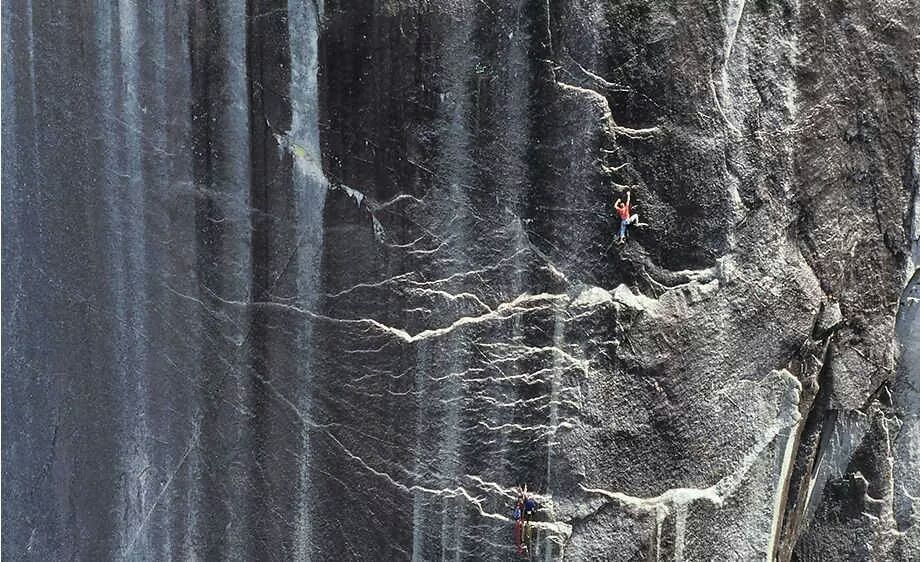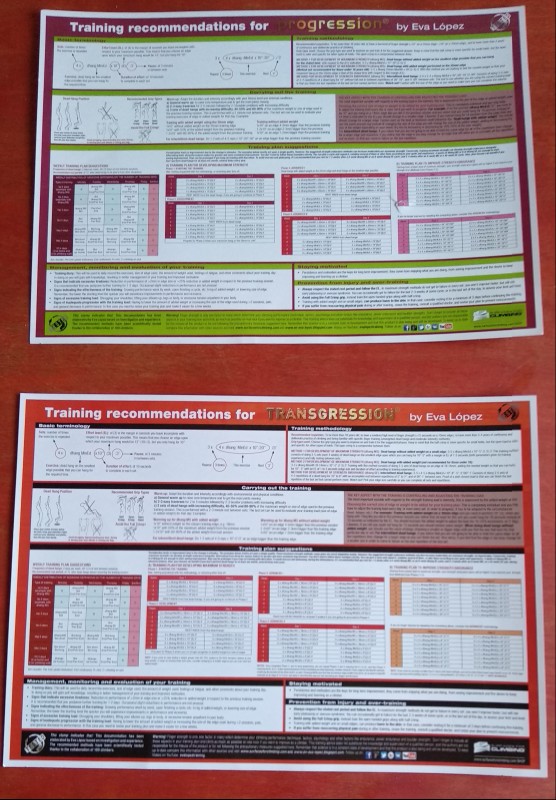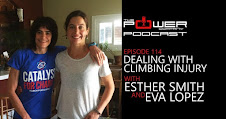Spanish version
I- Overview
1.1. Basic rules
The two methods we are going to discuss have the following rule in common: stay for a long time on the wall, climbing at a low intensity.1.2. Rhythm
Uniform, steady and adjusted to the previously planned load. You'd be right to guess that the longer the activity, the lower the average pace will be, so that we will move at a slow or very slow speed, stopping just for the time needed to choose the next hold.Occasionally we will stop for 1-2 seconds to shake our hand a bit, in order not to exceed the set load. But it is not a characteristic of this method to shake off for more than 3 seconds or to stop at a resting point; these are typical of a different method that will be the subject of other entries.
 |
| Eva López "self-pointing" the right holds for Capacity training. Picture: Javipec |
1.3. Control of the Intensity
This is the most important factor to achieve the desired training effects. When training your capacity it would be ideal to be able to discern what holds and wall angle will allow us to maintain a 1-2 level of pain in the forearms (very mild pump).- If we don't comply with that and go beyond level 2, we have to realize that we are not training our capacity anymore, and we should move to a less steep wall or use bigger holds; if necessary, we will even stop at a good jug until we go back to the desired subjective sensation.
- If we need to re-adjust too often, we have to ask ourselves if the set duration is too long, the pause between sets too short or the chose holds/angle aren't ideal at this moment.
1.4. Where to train: How steep, what holds? Route or traverse?...
In general we will seek a wall with the steepness and holds that allow us to limit the forearm pain (level 1-2) and fulfill the programmed volume. With this in mind:- If we train on a route that is already set, it should be homogeneous and long. If it's shorter than the desired duration we'll climb and unclimb it as many times as needed without descending to the ground.
- If the wall is short like in a bouldering gym, and there are no set routes, we will choose our holds as we climb (like playing pointer game alone), trying to move up and down as possible, rather than going laterally all the time.
- The wall angle and hold size depend on our level. Some examples:
- an elite climber can work this facet of aerobic endurance on a 130º wall on medium holds (2-phalange deep) and stay there for a long time.
- a beginner or someone with a lower level will only be able to comply with the volume on slabs and vertical walls with good holds (3-phalange deep), and for a limited time at that. This time issue will be addressed later.
 | |
|
II- Method Categories
Attending to the continuity of the action there are two methods:2.1. Continuous Method
2.1.1. What is it?It consists on climbing or "staying" on the wall for a prolonged time without descending to the ground. It is the equivalent of continuous running in track and field. Once you step off the floor you do not go down until the time expires. This is the most simple and basic method, with some particularities that will be explained later.
2.1.2. It is recommended for...
- early stages of training for lower and medium level climbers
- a General Mesocycle in the Season for those who want to climb longer routes (more than 15-minute long), onsight 20+ meter long routes, or climb multi-pitch routes
- active recovery sessions
-going back to training after a rest period or an injury, for all levels
2.1.3. Characteristics
From 5 to 45 minutes of continuous climbing.
 |
| Andrew Boyd and Sig Isaac on The Opal, Squamish (Canada). Photo: Rich Weather. Source: www.richweather.com |
2.2. Discontinuous Methods
2.2.1. What is it?In these methods the total time is divided into parts called repetitions or bouts, the intensity is low-medium, and the rest time between repetitions are incomplete. It is also known as interval training.
The rationale for this method is that by dividing the time, each segment can be performed at a higher intensity than it would be if the activity was continuous.The result is that the load is more intensive, and the effects somewhat different to the previous one. Furthermore, the stimulus does not take place only during the climb, but also at the recovery time. In fact, the original method used by long distance runners was based on the idea that the greater influence on cardiovascular performance took place during the pause for recovery, when the heart rate goes from 170-180 bpm down to 120-140 bpm. As readers of this blog already know, we won’t control the intensity by measuring our heart rate; we shall guess our muscle recovery by feeling how pumped our forearms are and how swollen they look, to get an idea of how capable they are to keep on doing medium and low intensity contractions.
Among the panoply of discontinuous methods, we will use the following to develop capacity:
2.2.2. Long Interval Training
The term long (or “extensive”) refers to the typical low intensity-long duration load, by contrast with the high intensity (or intensive) variant that we will explain in the context of a different quality.2.2.2.1. Recommended for
- early stage of the season for high and very high level climbers.
- Specific Mesocycle in the Season for low and medium level athletes who have already used the continuous method during the general mesocycle, and want to climb long (more than 15 minutes) routes, onsight routes longer than 20 meters or climb multi-pitch routes.
- high and very high level climbers who want to gain or recover capacity during a specific time of the cycle.
 |
| The long interval method can be used by medium and high level climbers during the general mesocycle to achieve the capacity that they will need to endure more intensive methods later in the specific mesocycle, and to increase their chance of sending their anaerobic-aerobic endurance/power-endurance projects. Picture: Lee Smith on Bohica, 5.13b, Motherlode, Red River Gorge, Kentucky (USA). Photographer: Nathan Welton. Source: Nathan Welton Photography |
2.2.2.2. Characteristics (to be adjusted to level and goals*)
- Repetition duration: 4-5 to 20 minutes.
- Recovery duration: 45 seconds to 3 minutes.
- Total session volume (number of repetitions x repetition length): 8-60 minutes.
(**) This reads: perform 2 to 8 repetitions, 4 to 20 minute-long each, and rest 45 seconds to 3 minutes between them (in this case we can assimilate repetitions to sets)
2.2.3. What method to choose, continuous or long interval?
Sometimes our goals and level won't be our only limitations, and other "practical" factors will enter the equation:If our gym is basically a set of really steep overhangs and/or small holds and we are not able to stay for a long time on such wall, we will opt for the long interval method. But... suppose that even resorting to shorter repetitions our physical sensations are harder than what is expected for this type of training; then it will be long until we can train our capacity for real.
[Paradoxically, the most suitable method to begin training and climbing can't be performed at most of the climbing gyms that we have access to here in Spain]
 |
If we can only stay on the wall for a short time, then either we won't be able to develop our capacity, or we will need to resort to something else... like the intermittent method
|
When we are lower level climbers our finger flexor muscles lack the required maximum strength… every session can end up being a strength or endurance workout. To mitigate this situation I suggest a variant of the previous methods:
2.2.4. Intermittent Method
2.2.4.1. What is it?It is a possibility for beginners, and for those who can't go to an "easy enough” wall. It can also be useful after an injury or prolonged resting periods.
The goal is to meet the time requirement, doing brief rests on the floor during which we will stop our watch. It's the equivalent of "jogging" for runners. The workout could be like this:
You decide the total climbing time beforehand (a short one, 3-5 minutes) start your watch and begin climbing. When your forearms pain level is above 2 and it does not go down even by resting at a good jug, you go down to the floor and stop your watch; when the fatigue subsides, you start your watch again and resume climbing. Repeat until you meet the desired time.
III. The million-dollar question: How many sets, repetitions and what pause do I choose?
When it comes to producing concrete numbers, something you would undoubtedly appreciate to start training right now, I remind you that I am not in favor of one size fits all recipes. This not only goes against my vision of training (individualization and specificity), but also is inefficient. It can lead to overtraining, or the opposite: staying below your threshold and getting no effects.But everyone needs a starting point... so I will propose a basic guide for volume, set duration and recovery duration that is reasonable for each sport level/training experience. Use it, experiment and, from the sensations you get, start tailoring and planning your own training.
 |
| Luis Alfonso Félix trying his project "Tres Cromosomos", 9?, Otiñar, Jaén (Spain). Picture: Bernardo Giménez. Fuente: Luis Alfonso Felix facebook page |
3.1 Basic guide
3.1.1. Number of repeats and total session volumeIn general, we can do longer sets and longer sessions:
- the more experienced with this kind of training we are
- if we have more endurance than strength
- the higher our level is
- the longer our project is: it's not the same to train for a trip to Rodellar, where we can expect good rests and long climbs, to the Motherlode at Red River Gorge, or to the bouldery routes at Frankenjura, where these contents can even be unnecessary.
- the longer the type of climbing is: multi-pitch versus sport climbing, onsighting or working a route...
From 8 to 12 minutes (# of repetitions x repetition duration) for lower level or short training experience,
15-30 minutes for medium level,
More than 40 minutes for advanced,
One hour or more for very high level or multi-pitch.
In general, choose the workout time (continuous of discontinuous) and the number of repetitions looking at these two factors:
- Minutes and number of repetitions that you can maintain the key physical symptoms for.
- Minutes and number of repetitions that you have used in the previous training cycle.
3.1.2. Measuring Volume: Time vs Movements
Perhaps you prefer to count movements instead of time; then keep in mind that doing a simple traverse on good holds takes 3-5 seconds per movement. Leading a previously set route, you spend up to 5 seconds to clip, and around 3 seconds to chalk up. If there is an anchor every 4 moves, a 20-move route that you already know takes about 2 minutes to climb. By contrast, 5 minutes of easy, not very technical traverse can add up to 100 movements.
 |
| To train Capacity, it's best to have access to a wall with relatively easy and homogeneous (in terms of angle, holds, and intensity) routes. Photo: Stone Summit Climbing and Fitness Center, Atlanta, USA |
In my case, I can only go to a bouldering gym, so leading long indoor routes is not an option. That's in part why I prefer to count minutes, and "self-point" the moves instead of setting a route beforehand; this has its advantages:
- More accurate measure of volume
- Focus on volume over intensity
- Prevent overuse by not repeating the same moves over and over
- Expand the technical repertoire
- More finely tune the intensity during each set, instead of ending up unintendedly working a different quality because the route I set was too hard and I wanted to send it anyway.
3.1.3. How long must the rest period be? The recovery dilemma
The rest period between repetitions has to be:
a) Incomplete. It won't allow us to completely recover.
b) Enough. It will allow us to do all the planned repetitions.
In the traditionally called "endurance" sports they use the ratios 1:1, 1:0.5, 1:0.25, meaning the the rest is equal, half or a quarter of the exertion time. Although these formulas are valid when speaking about heart rate recovery (global factors), they are not suitable for factors related to recovery of strength or recovery of the local physiological levels typical of fatigue in climbing. Most of the time we will be able to use shorter pauses for almost every method. In general, the longer the training experience and the higher the level, the shorter the recovery can be tolerated and vice versa. Some examples:
- For 3 4-minute sets, try a 2' pause if you are of lower-medium level (3x4' easy climbing :2').
- 3x5' easy climbing :2' for medium level.
- 7x5' easy climbing :1' for high level.
- 4x8' easy climbing :90" for high level.
- 8x5' easy climbing :45" for very high level.
- 3x20' easy climbing :1' for very high level.
3.2.(*) How to individualize after all this trying?
There's no option but to analyze what of the different combinations of # of repetitions, repetition and rest period is more adequate for our goal: complete the time, monitor the sensations. It can mean going beyond the margins I have proposed, or staying well inside these limits. (Never take the theory verbatim! Take a moment to think about how you really are, and you won't miss).In any case, I recommend a bit of modesty. Start with "easier" workouts and the least volume. You'll be able to progress from that point. One advantage of being new to a method is that it provides noticeable gains [almost] regardless of the load. We will improve even if we don't use the greatest volume or the shortest pauses. The result is a more sustainable long-term development avoiding unnecessary effort and suffering, and perhaps even skipping some injuries.
V. Summary of Methods for Developing Capacity in Climbing (also known as ARC)
 |
| Clic the image to enlarge |
RELATED LINKS













 https://orcid.org/0000-0003-0304-5290
https://orcid.org/0000-0003-0304-5290







